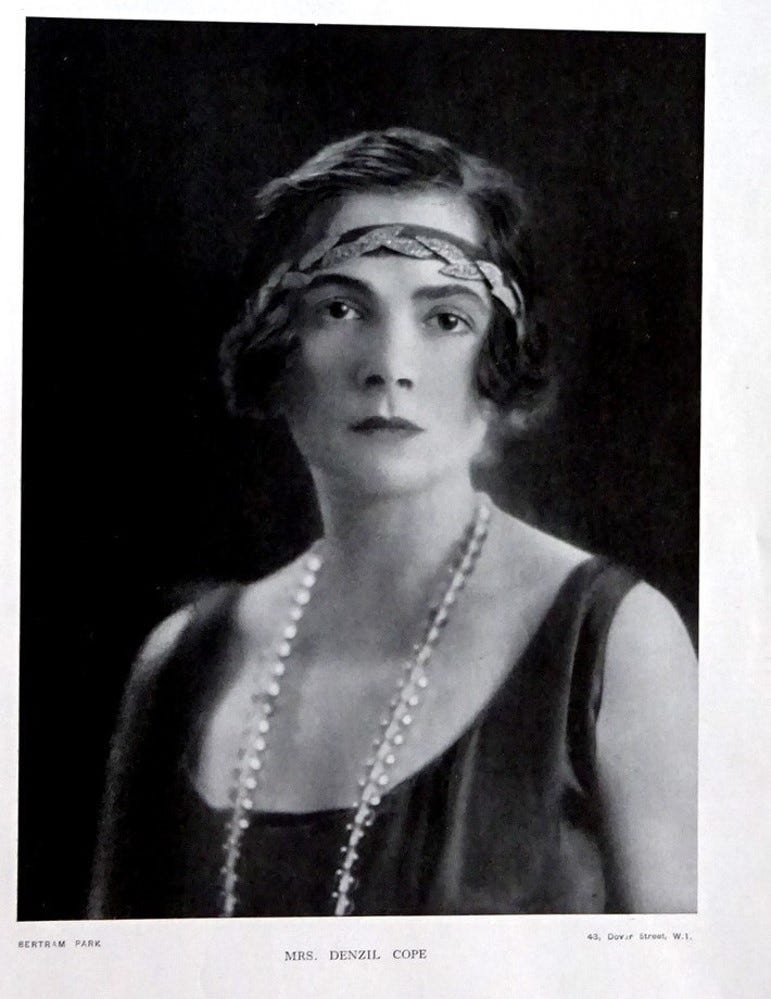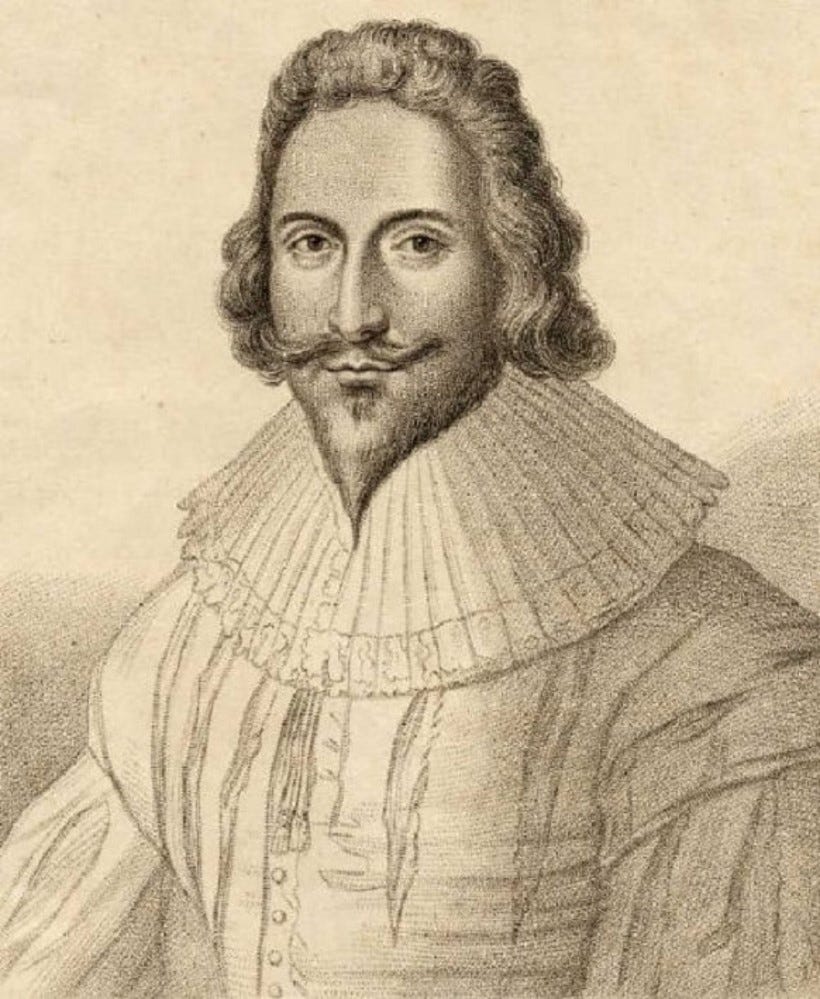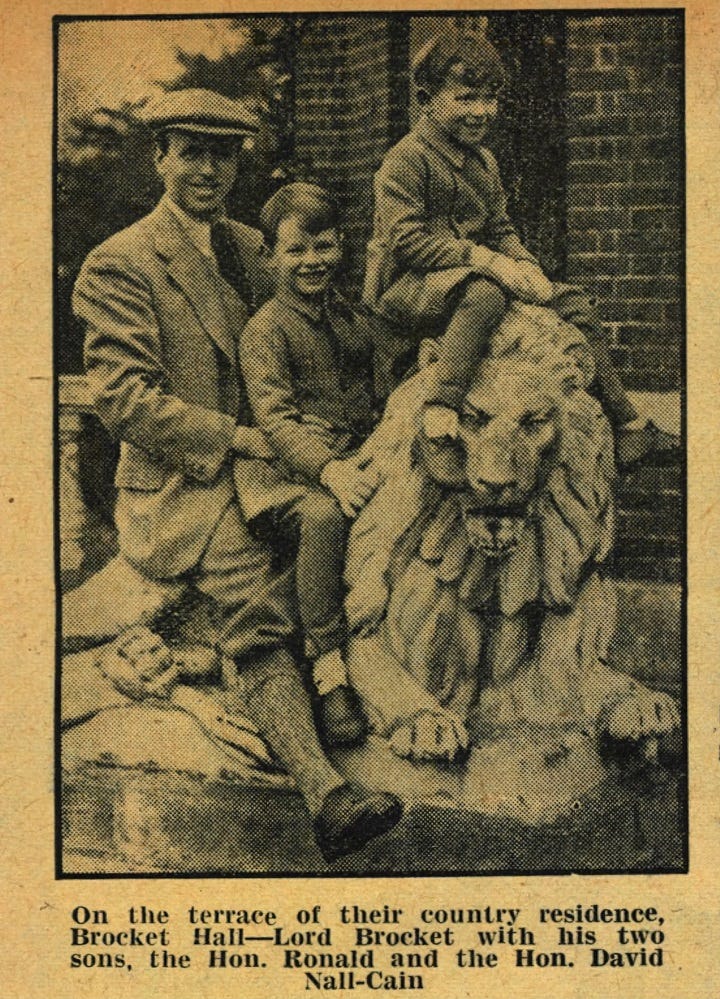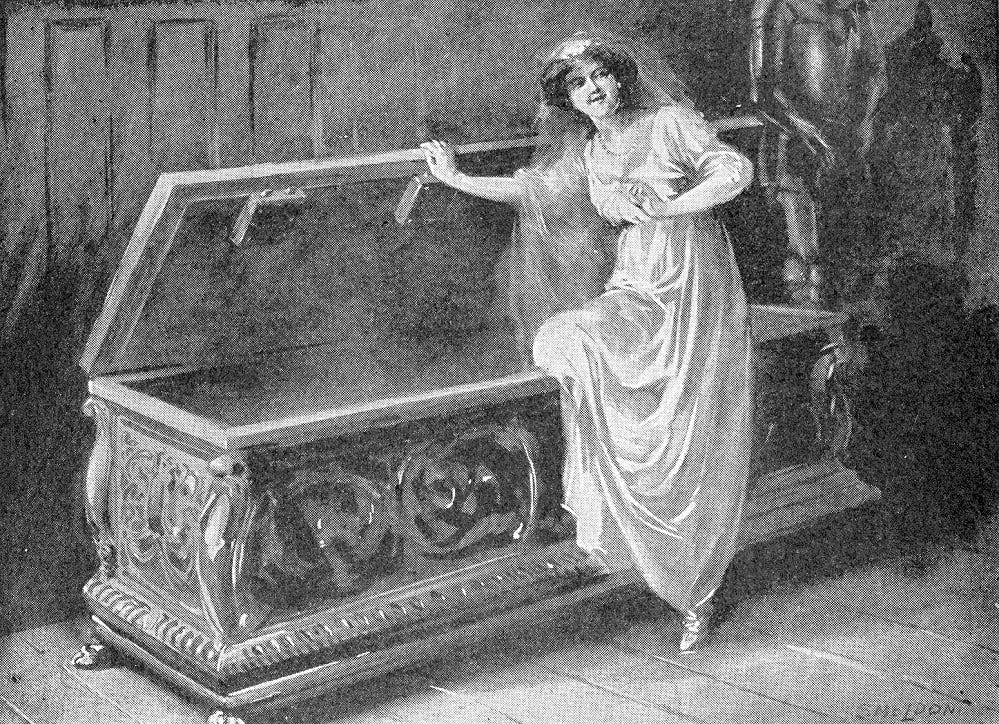Lord Lovell's Lost Bride
In 1923, Edna Hilton an American socialite married Capt. Denzil Cope. They moved to Bramshill Castle in Hampshire, England. This was an ancient home which harbored a terrifying ghost story.
Captain Denzil Cope (1873-1940), was the heir of Sir Anthony Cope, the chief of the ancient family that had long occupied the old house. His young bride Edna (1892-1977), who was 20 years his junior, was one of the Hilton family members that inherited part of the Stewart millions.
The Cope’s ancestral home was built by Lord Zouche, an adventurer and statesman. He bought the property from Thornhurst in 1605. The original structure dated back to the 14th century. Present day only an ancient gateway, and a part of the cellar of the earlier building remains.
Zouche’s close friend was William Cecil, Queen Elizabeth's minister. Among his other acquaintances were Francis Bacon, the Earl of Leicester, the Earl of Essex and Sir Walter Raleigh.
Lord Zouche demolished a large part of the building and began to build the Bramshill House of today. It was built in the form of an E, an homage to the queen, with a statue of Lord Zouche in full armor at the entrance.
Throughout the years the family accumulated treasures in the form of pictures, furniture, old plate and beautiful metal-work. Inside its walls were said to be secret chambers.
Before his acquisition of Bramshill, La Zouche married his cousin Eleanor Zouche in 1578. He had two daughters, Elizabeth and Mary. After the birth of his last daughter in 1582 he separated from his wife permanently, and left her destitute and penniless until her death in 1611.
Zouche married Sarah Harrington a year later, but they had no children.
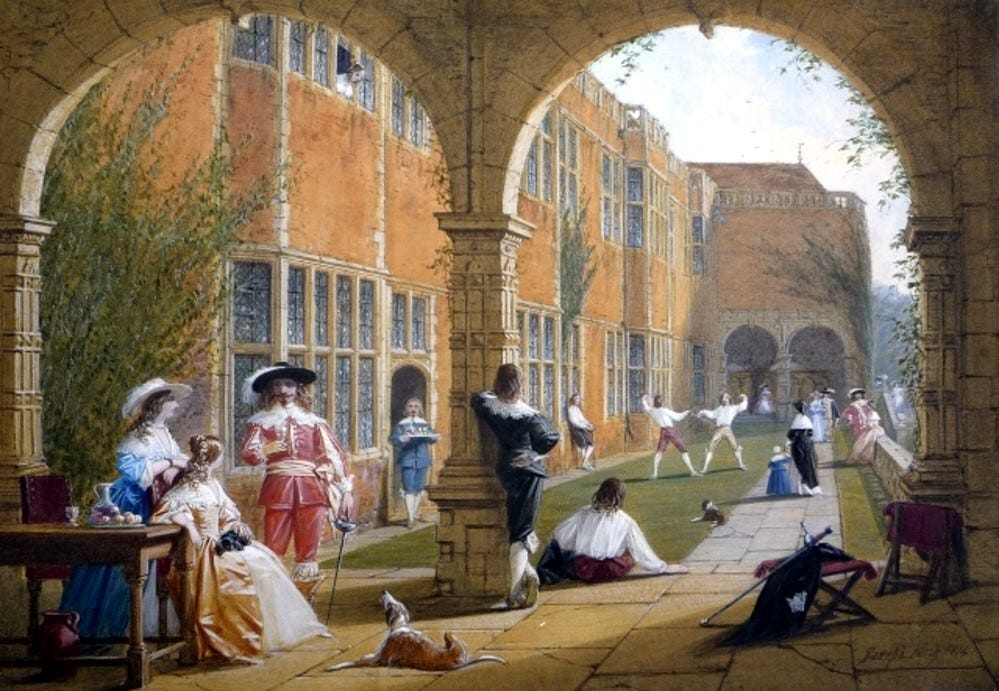
In 1621, a scandal visited Bramshill when George Abbot, Archbishop of Canterbury came to consecrate the chapel for Zouche. During a stag hunt he killed a gamekeeper with a cross bow, when the man came across his line of fire. Zouche said the death was accidental, however the abbot’s reputation suffered for it.
Around this time, Zouche involved himself in a minor scandal encountered by his longtime secretary Samuel More. More had married his cousin Katherine in 1611, and five years later it was charged that she had conceived four children: Elinor, Jasper, Richard and Mary by her lover. Zouche who was a New England Counsel commissioner had the four children, without their mother’s knowledge, sent to the Plymouth Colony as indentured servants on the ship the Mayflower.
Zouche died in 1625, after suffering illness for some time. Where he was buried remains a mystery, and all that is known is that it was not at the parish church at Hackney.
On Zouche's death, the Barony of Zouche fell into abeyance between his daughter Mary and the heirs of his daughter Elizabeth (died 1617). The abeyance ended in 1815, with the title going to one of Elizabeth’s descendants.
In the meantime, Bramshill came into the hands of the Earl of Antrim, and then the house was partly destroyed by fire. In 1640, it was sold to Sir Henly, and it wasn’t until 1699 that Sir John Cope, the sixth Baronet purchased it. The estate was occupied by the Copes until 1935.
The exact date of Bramhill’s most famous ghost story is not known, however as the tale goes, Anne Cope or possibly an unnamed beauty from Lord Zouche's lineage was promised to Lord Lovell in marriage (in an alternate version the groom was Lord Hugh Bethell [1615-1679]).
The date was set to coincide with Christmas celebrations, which were known to be marked with great merriment. The great house was filled with guests, most of them from the noblest houses in England. A sumptuous Yuletide feast was served as musicians played up in the minstrels' galleries. The most luscious meals were served accompanied by the most succulent delicacies for dessert. After the dinner the bride grew weary with the merry-making, and among the younger guests proposed a game of hide and seek. The first to hide would be the bride, and the man that found her would be rewarded with a kiss. She hid and they hunted and hunted. For several hours they sought her, marveling at how clever she was to hide so well. Guests and servants eventually searched the house from top to bottom. The hours passed, and none could find her. Some wondered if perhaps the young bride ran away from her husband.
Days turned into months and then years, and the bride was never heard from again. Lord Lovell never believed his young wife deserted him, and he knew she did not return to him because she was unable to do so. His whole life was spent in looking for her, and her father in order to accommodate his son-in-law allowed him to stay in the castle.
Lord Lovell grew old, but he never stopped looking for his bride, and most considered him a harmless madman. Fifty years after his short marriage, he was running his hand over paneling in a room on the top floor. He hand came across a spot on carved woodwork, and the paneling sprung open. Inside stood an ancient oak chest, bound in iron. It seemed like a secret place to store important documents in. With anguish and excitement making his old heart thump he found a tool and broke open the chest.
Inside was his lost bride; a skeleton inside her wedding gown now stained with age. Her hand was raised in her last desperate attempts to gain her freedom. Perhaps she had known the chest would make a secure hideaway, not understanding that once inside she would not be able to open it. The smell of her decomposing corpse would have been carried away by a nearby chimney, and being situated on the top floor not many would go up there. Once this mystery was solved Lord Lovell died shortly thereafter.
Phantoms appeared to guests and manifestations were witnessed by family and staff.
Edna was quoted saying: "The chest in which 'The Mistletoe Bride' was found is shown to visitors at Bramhill House, Hampshire, the residence of Sir John Cope." As the new Mrs. Cope she was the owner of the famous chest, and many were curious to know if she would hear what many who had stayed in the house heard, which was the moans of a woman in terrible agony. Also muffled sounds like a person beating on the interior of a wooden chest.
One of the stories concerned an English socialite who paid a visit to the castle. Afterwards she told this story to a friend: "During the night I had a most terrifying experience. Shortly after midnight I was awakened suddenly with a sensation that I was not alone in the bedroom. Then from behind the ancient oak wainscoting I heard noises of light, hurrying footsteps. What followed was even more terrifying. I heard moans of the most heartrending kind and then strange sounds like hands beating upon a wooden partition. The moans so terrified me that I fainted away, and it was daylight when I recovered consciousness. I made an excuse for leaving the castle and hurried away."
Another visitor described that she had been awakened after midnight by the phantom of a girl dressed in a gown dating back three centuries, and she glided through the room, holding a candle.
Servants would give up their positions after having encounters. Some actually saw the ghost of the bride, and others said they just felt uneasy being there. One of the retainers at the castle who left, said that in the stillness of the night he would hear the sound of bony feet clacking its way up the stairs to the attic. He could hear the swish of long skirts. All this would end with the sound of a thump like the falling of a chest lid. He heard this on several nights, he thought it was the bride reenacting what happened on her wedding night.
There is a story told that the chest was removed from Bramshill by the widow of Sir Denzil Cope after his death in 1812. It was said to be large enough to accommodate a woman inside, but supposedly there was no history of a bride from the Cope family dying soon after her marriage. The chest left at Bramshill, purported to be tomb of the bride, is not the original one.
At one point there was dispute as to whether the story of the Mistletoe Bride took place in Bramshill Castle versus Minister Lovell Manor House, which was the seat of the Lovell family. This house was known to have secret passages and chambers.
Research revealed another tragedy. One of the Lord Lovells participated in a rebellion against Henry VII. The rebels were defeated, and in June 1488, Lovell was granted a safe conduct by King James IV of Scotland and, after that date, he disappeared without a trace. It was said he took refuge at his manor house but told no one he had returned. He hid in a secret passage, and when the soldiers searched the premises, they could not find him and eventually left empty-handed. It was then Lord Lovell realized he did know how to operate the mechanism which would free him from the hidden chamber.
He beat upon the walls, but none heard him, and he died of thirst and starvation. Years passed and his family believe he died during the rebellion. His son inherited the title.
Twenty years passed and alterations were made in the house. The secret chamber was discovered, and Lord Lovell wearing his armor was found dead sitting before a heavy table. Later a grandson of the one who perished trapped in the secret passage became the husband of the poor "Mistletoe Bride".
In 1728, antiquarian Francis Peck received a letter from William Cowper which related the discovery of the underground room at Minster Lovell Hall where Lord Lovell had been entombed alive.
This version though is highly improbable, since in 1485, Viscount Lovell’s estates had reverted to the crown. In order to hide in the house he would have had to sneak in under the nose of Jasper Tudor, uncle to Lovell’s greatest enemy, Henry VII, which is unlikely.
As a wanted man, Francis Lovell probably escaped back to Burgundy via Scotland, and thought it wiser to retire into obscurity, then lose his head to the executioner. Little did he suspect his family name would be connected to an ill-fated young woman.
Like other mysteries surrounding this ghost story, if indeed the skeleton of an immured man was found at Minster Lovell Manor, his identity as well as how he ended up there is destined to remain unknown.
Throughout the 1800s, songs, poems and etchings were made of the Mistletoe Bride, with the first emerging in 1809 under the title The Melancholy Occurrence. Several others were written, the most popular being the 1830s work, The Mistletoe Bough by Sir Henry Bishop.
Susan E Wallace wrote her own version in 1887 titled The Old Oak Chest and by Henry James as The Romance of Certain old Clothes in 1868.
The Mistletoe Bough by Thomas Haynes Bayley (1797-1839) was a popular song of the day that spoke of the sad fate of the lost bride.
There then had she found a grave! Within that chest had she concealed herself,
Fluttering with joy, the happiest of the happy,
When a spring lock that lay in ambush there,
Fastened her down forever.
In 1904, Percy Stow made the short film The Mistletoe Bough.
In an alternate version, the unlucky bride was not English but Italian. Her name was Genevre Orsini and she died as described above in 1727. When the carved Italian chest was imported by the fifth Baronet Cope, Genevre’s ghost followed the piece of furniture that sealed her fate. Sir John Cope did spend many years of his life in Italy, which lends some credence to this story.
During the early 1930s, young Joan Penelope Cope and her brother often awoke to find the White Lady by their bedside. Soon after, Bramshill with its 4,000 acres was sold to the 2nd Baron Brocket in 1937, and he was the last private owner. In 1938, Queen Elizabeth, married to King George VI visited Bramshill House when she acted as godmother for Lord Brocket's daughter.
A few months later Lord Brocket came with a peace message from Hitler to Prime Minister Chamberlain. He had been one of the British guests invited to the Nazi Congress at Nuremberg, and would go on to be known as a Nazi sympathizer.
During WWII the Red Cross used Bramshill as a maternity home, and then it housed exiled King Michael and Queen Anne of Romania from 1950 to 1952.
In a passage off the gallery is a room called "Flower-de-luce" due to the gold fleurs-de-lys in the center of each panel. It is here the White Lady haunts. No one is certain if this is the Mistletoe Bride
Michael I of Romania who was staying in the Fleur de Lys room, asked to be moved to another room so as not to be disturbed by the young woman in white who passed through his bedroom every night. The scent of lilies preceded her arrival. She is said to also favor the Long Gallery, and the area around the chest.
Queen Anne of Romania saw her sitting in the King’s room. An exorcism was performed, but it had had no effect.
She’s also been seen on the terrace, and was seen by Sir William Cope and his family. She melted into a balustrade when a butler approached her.
Bramshill House became the location of the Police Staff College in 1953, and was later home to the European Police College.
In 1986, an Indian police officer in training at Bramshill was passing through the chapel drawing room when he smelled a soft fragrance of lilies that could only be found in a small area facing certain chairs. After a while the scent dissipated.
Due to the expense of upkeep it was described “in a poor state of repair” by 1989.
OTHER GHOSTS
It’s not only the Bride who is said to haunt Bramhill. There is also the Grey Lady, a Cope family member, who has auburn hair and is dressed in a gray, sleeveless robe which is how she earned her name. Her story of ill fortune goes back to the early 17th century where her husband, a dissenter was tried and beheaded. She is supposedly searching for husband, and her son.
Another specter is the Green Man seen near the Pale Pond, which once covered 18 acres. He has been sighted standing on a little bridge near the Tudor gatehouse. He is another Cope who died by drowning in 1806. Dressed all in green with only black boots, he is easily recognizable.
It’s unknown if the sighting of another ghost might be the same one. This phantom has been name the “The Gardener”, who supposedly drowned in the lake on the northwest side of the estate. Dogs alert when they come to a tunnel formed by the branches of overgrown trees and refuse to walk through it.
In 1972, a security officer saw a man in a grey, flannel suit on the path outside walking to the mansion. He came in through the open door, crossed the hall and disappeared into the wall on the opposite side. The wall was once an archway which had been plastered over years before.
Four years later, another security patrol came face to face with a ghost dressed in tennis gear and carrying a racket. He believed this was Ronald, son of Lord Brocket. He died in 1961 from a brain tumor when he was only 32 years old. It’s not certain why he believed this was Ronald Nall-Cain, who at the time of his death lived at a farmhouse in Maisiemore. Also the ghost was said to be dressed in the fashion of the 1920s.
Another ghost is described as an old man with a beard who haunts the hall where the mistletoe bough chest was located.
The chapel drawing room is haunted by a woman dressed in the fashion of the early 1700s, and a knight in armor. In the chapel itself, another lady ghost wearing the style of the 1600s with a tight bodice and a full skirt is seen, as well a nun.
Upstairs is a bedroom where a child’s tiny hand is placed in the hands of visitors. Some believe this child belongs to the Grey Lady. Another room, on the first floor has a spirit walking two feet above floor level, which was the original height of the room.
STRANGE COINCIDENCES
Edna Cope through her mother Dorothy Walbridge (Phillips) Hilton, was a Mayflower descendant. Her ancestors traveled on the same ship which Lord Zouche exiled the poor children of his steward as indentured servants.
Edna’s grandfather (through her mother Dorothy) was Dr. James Phillips. He was born in 1831 (London) and was the nephew of Sir Fordell Phillips, once Lord Mayor of London. He was a surgeon in the Crimean and American Civil Wars. While in the Navy Department Dr. Phillips married a daughter of Gen. Walbridge, which produced two daughters. In 1874, Mrs. Phillips filed a petition for divorce against her husband on the ground of extreme cruelty and drunkenness, and neglect to support her.
After the divorce Phillips practiced medicine in New York, and became estranged from his family. Eventually he became destitute and ill, and was moved to City Hospital on Blackwell’s Island. In 1914, moments before his death, he gave his daughters’ names, which saved him from being buried in a pauper’s grave, since they came to reclaim his remains.





